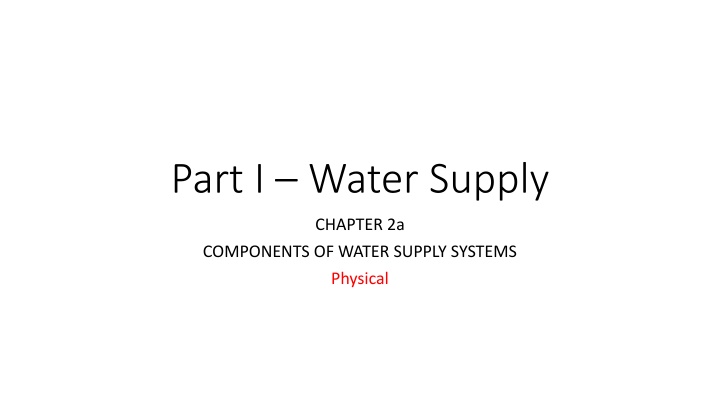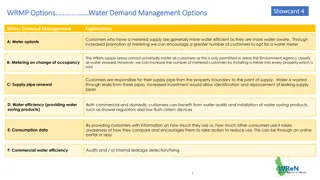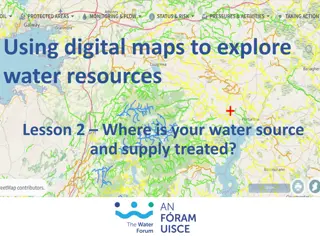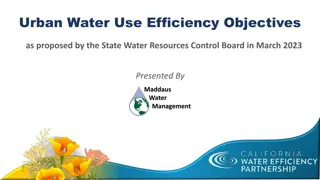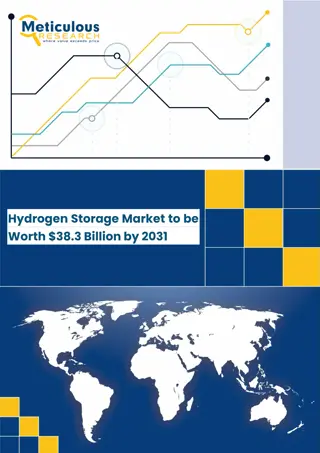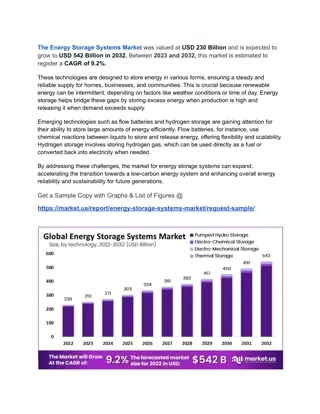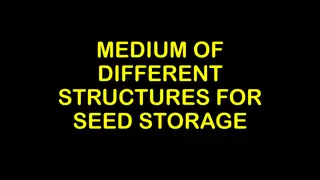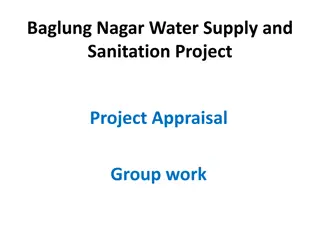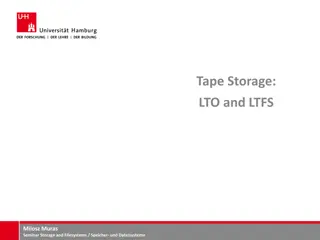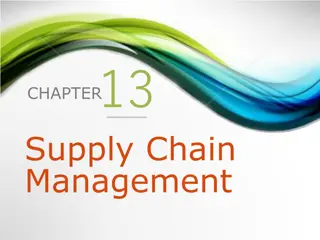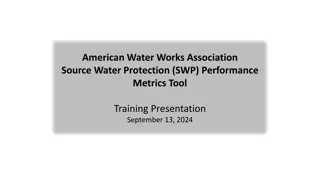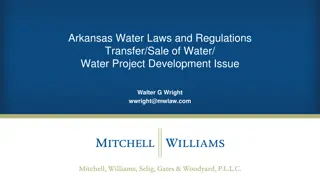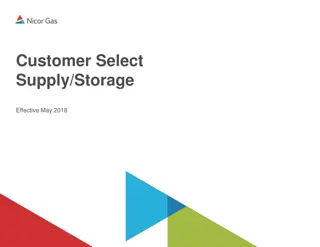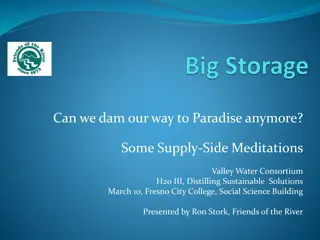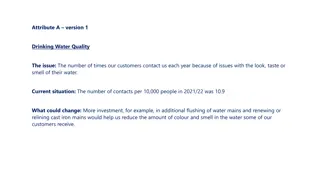Components of Water Supply Systems: Physical Source, Storage, Treatment
Water supply systems consist of various components such as physical sources, storage facilities, treatment processes, and transmission methods. The source component directly relates to the overall demand of the system and is developed to cater to the maximum day demand. Factors like population size, settlement type, socio-economy, climate, environmental factors, and policies affect the determination of water sources. Seasonal storage is crucial to bridge the gap between water availability and demand, with considerations for rainfall variability. River intake plays a key role in water yield for water supply systems.
Download Presentation

Please find below an Image/Link to download the presentation.
The content on the website is provided AS IS for your information and personal use only. It may not be sold, licensed, or shared on other websites without obtaining consent from the author.If you encounter any issues during the download, it is possible that the publisher has removed the file from their server.
You are allowed to download the files provided on this website for personal or commercial use, subject to the condition that they are used lawfully. All files are the property of their respective owners.
The content on the website is provided AS IS for your information and personal use only. It may not be sold, licensed, or shared on other websites without obtaining consent from the author.
E N D
Presentation Transcript
Part I Water Supply CHAPTER 2a COMPONENTS OF WATER SUPPLY SYSTEMS Physical
OUTLINE PHYSICAL SOURCE STORAGE TREATMENT TRANSMISSION DISTRIBUTION INSTITUTIONAL ASSET MANAGEMENT ENVIRONMENTAL MANAGEMENT
POLICY/ GOVERNANCE (Design Standards /Operating rules and regulations) WATER (SUPPLY) POPULATION (DEMAND) WATER SUPPLY SYSTEM ENVIRONMENT (Availability / Climate / Pollution) SOCIO- ECONOMY (DEMAND) SETTLEMENT (Demand Centre)
Source Water Supply system begin with Source / Supply side The Source Component is directly related to the overall demand of the system Sources are developed to cater mainly the maximum day demand Usually, water supply sources are expected to satisfy the maximum day demand when the supply is minimal / during ??? (Surface or Groundwater) Source is directly related to climatic conditions of the area / catchment or basin
Factors affecting source determination Factors Details POPULATION Size and growth rate SETTLEMENT Rural or urban SOCIO-ECONOMY Prevailing economic activity and living standard Climate/Hot or cold/ Arid, semi arid / Pollution risk /Protection requirement ENVIRONMENT POLICY / GOVERNANCE / STANDARDS Water Right/ Water Abstraction Guidelines /Supply standard /minimum
Storage / Source Bridging gap with seasonal variation Basically depends on the degree of variability of rainfall and the water demand Usually mass curves or tabular calculation of cumulative deficiency is used to determine the quantity of storage Different types of dam are constructed depending on the specific conditions of the site / Usually for more than the usual design period GW is considered as Natural storage but pumping or withdrawal rate should be less than natural recharge rate / Can be phased within design period River diversion does not require seasonal storage / Minimum flow covers maximum daily demand
River Intake Yield River Intake Yield Hydrological yield No storage Minimum storage (7 days) / Could also be less than that Yield constrained by different factors Methods of estimation: Flow duration curve Statistical analysis on natural flows Probability plot of low flows
Flow duration curve Flow duration curve
Yield of Direct Supply Impounding Reservoirs Yield of Direct Supply Impounding Reservoirs Storage + + Inflow critical the over drawdown period = = Yield Length of critical the drawdown period
Reservoir Characteristics Reservoir Characteristics
Catchment and Reservoir Yield Catchment and Reservoir Yield Catchment yield is total yearly runoff volume entering or passing the outlet point of a catchment Net inflow into a reservoir can be obtained by adjusting the catchment yield for losses that include evaporation, seepage and required minimum downstream flows Reservoir yield is the amount of water that can be drawn from a reservoir in any specified time interval
Reservoir Yield Reservoir Yield Safe (Firm) Yield: maximum quantity of water that can be guaranteed during a critical dry period (lowest natural flow period) Secondary Yield: water available in excess of safe yields during periods of high flow
Storage Storage- -Yield Relationship Yield Relationship Two Types of Problems: The storage required at a given site to supply a given yield (planning) Determine the yield from a given amount of storage (final design)
Reservoir Capacity given Yield (Rippl Diagram/Mass curve)
Mass Mass Curve Curve & & Constant Constant Yield Yield Lines Lines
Firm Yield Curve Firm Yield Curve
Yield given Storage Yield given Storage Yield = Flattest Slope
Reservoir Capacity Determination using Sequence Peak Reservoir Capacity Determination using Sequence Peak Algorithm Algorithm An alternative to Rippl diagram when: Long data series is used Demand varies
Site selection of a dam: Site selection of a dam: Following the important factors considered for the selection of site for a dam: Catchment characteristics Length of dam Height of dam Foundation conditions Availability of suitable Spillway location Availability of suitable construction materials Storage capacity Construction and maintenance cost Access to the site Options for diversion of river during construction Compensation cost for property and land acquisition Quality of water Sediment transport Environmental conditions 1) 2) 3) 4) 5) 6) 6) 7) 8) 9) 10) 11) 12) 13)
Intake site selection criteria Avoid locations that are near wastewater discharge points and pollution hazard is likely as well as areas with poor water circulation. Select locations that enable withdrawal of water from a range of levels- lowest to highest levels. Magnitude and direction of stream or current velocities should be such that they do not affect the function and stability of the intake structure. The limiting velocity should be 0.6 m/s and avoid locating a river intake at the curved part of the river. Reliable access roads and power sources should be available to facilitate operation and maintenance of the intake structure The site for intakes should be near to treatment plant Sites that interfere with navigation requirements, if any, should not be considered Locations that result in major environmental impacts should be avoided
Intake Design Considerations Intake Design Considerations Design capacity = Q max-day Intake velocity should be 8 cm/s so that suspended matters and fishes do not enter into the conveyance system. Too low velocities that require large intake ports should also be avoided. The vertical positions of top and bottom intake ports should be such that good quality water is withdrawn. Locate the top intake port at a distance not less than 2 m from the normal water level and the bottom port at least 1 m above the bottom. Major parameters of design: Size and layout of the intake port(s) Layout and bar arrangement of coarse screens Location and size of fine screen Head losses in the intake port, coarse and fine screens A check on the stability of the intake structure
Lake/Reservoir Stratification Lake/Reservoir Stratification Vertical stratification in lakes Epilimnion Thermocline Hypolimnion Water is most dense at 4 C.
Implications of Lake/Reservoir Implications of Lake/Reservoir Stratification for Water Quality Stratification for Water Quality Water in the hypolimnion layer has bad quality due to anaerobic condition During summer water in the epilimnion layer is not of good quality due to abundant algal growth Good quality water can be withdrawn from just below the thermocline layer during summer During winter better quality water can be withdrawn from the epilimnion layer During spring and autumn extensive treatment may be required due to mixing up of bad and good quality water
Groundwater Exploration Surface exploration Subsurface exploration 1. Test drilling geologic log drilling time log Water level measurement 2. Geophysical logging/borehole geophysics Resistivity logging Spontaneous potential logging Radiation logging Temperature logging Caliper Logging Fluid Conductivity logging Fluid velocity logging 3. Tracer tests and others Less costly than subsurface investigations 1. Geologic methods 2. Remote Sensing 3. Surface Geophysical Methods (a) Electric Resistivity Method (b) Seismic Refraction Method (c) Seismic Reflection Method (d) Gravimetric Method (e) Magnetic Method (f) Electromagnetic Method (g) Ground Penetrating Radar and others
Finding suitable well location- Pre-drilling investigations
Transmission Transmission lines could be between a source and treatment plant or a treatment plant to a reservoir just before a demand center Common characteristics of a transmission line is there is no withdrawal from a transmission line Transmission line could be either a gravity or pumping line or a combination There could pressure breaking and/or service reservoirs in a transmission system Management of pressure and leakage is the main issue in the transmission component
Treatment Treatment is necessary for any type of source the degree and the type differs from source to source Conventional Treatment Process are usually applicable for surface water GW requires minimal treatment except in special cases like GW with higher level of Fluoride, Arsenic, Sources downstream of towns or anyother development with point and non-point of sources of pollution require more intensive and combination of treatment process Treatment plants can be phased within the design period
Distribution Distribution component delivers the water to users Usually, have service reservoirs, have main, primary, secondary and tertiary lines, pumps and various appurtenances like Gate valves / air release valves, blow of valves, Reservoirs, distribution lines, pumps can be phased within the design period However, some components like pipes can serve more than one design period Distribution systems are designed to satisfy the peak hour demand / Balancing done through service reservoir NRW / Contamination are biggest risks in this component
